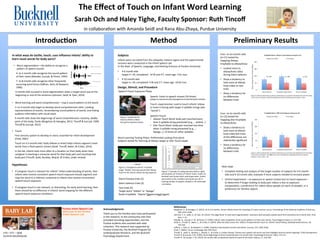
summer2015posterfinal
- 1. ≠ Next steps • Complete tes-ng and analysis of the target number of subjects for 4-‐6 month olds and 9-‐10 month olds, evaluate if more subjects needed to increase power • Control experiment – no exposure or speech stream but no touch exposure – to determine if longer looking to body part videos is due to exposure manipula-on, a preference for videos about people (or parts of people), or a preference for familiar objects In what ways do tac-le, touch, cues influence infants' ability to learn novel words for body parts? 6-‐month-‐olds succeed in word segmenta-on when a target word was at the beginning or end of the sentence (Johnson, Seidl, & Tyler, 2014) • Word learning and word comprehension – map a sound paNern to the world 3-‐ to 4-‐month-‐olds begin to develop word comprehension skills: crea-ng representa-ons of events, remembering sound paNerns of words, and linking auditory informa-on with visual input 6-‐month-‐olds show the beginnings of word comprehension: mommy, daddy, parts of the body, foods (Bergelson & Swingley, 2012; Tincoff & Jusczyk, 1999; Tincoff & Jusczyk, 2012) • Touch First sensory system to develop in utero; essen-al for infant development (Field, 2001) Touch on 4.5-‐month-‐olds' body (elbow or knee) helps infants segment novel words from a fluid speech stream (Seidl, Tincoff, Baker, & Cris-a, 2014) In the lab, infants look more o[en at a loca-on on their body when their caregiver is teaching a nonsense word for that body part and touching that body part (Tincoff, Seidl, Buckley, Wojcik, & Cris-a, under review) Hypotheses: • If caregiver touch is relevant for infants’ ini-al understanding of words, then infants who receive consistent speech+touch exposure should segment and map the word to a referent compared to infants who receive inconsistent speech+touch exposure. • If caregiver touch is not relevant, or distrac-ng, for early word learning, then there should be no difference in infants' word mapping for the different speech+touch exposure condi-ons. Subjects Infants were recruited from the LafayeNe, Indiana region and the experimental sessions were conducted in the Infant Speech Lab in the Dept. of Speech, Language, and Hearing Sciences at Purdue University • 4-‐6 month olds target n= 24; completed : 14 M and 9 F, mean age: 5.01 mos • 9-‐10 month olds target n= 24; completed: 4 M and 2 F, mean age: 10.02 mos Design, S-muli, and Procedure Speech+Touch Exposure Phase Word Learning Tes-ng Phase: Preferen-al Looking Procedure Subjects tested for learning of Always target or One Touch target The Effect of Touch on Infant Word Learning Sarah Och and Haley Tighe, Faculty Sponsor: Ruth Tincoff in collabora-on with Amanda Seidl and Rana Abu-‐Zhaya, Purdue University Acknowledgments Thank you to the families who have par-cipated in the research, to the community sites that provided recrui-ng opportuni-es, and the Purdue students who assisted with data collec-on. This research was supported by Purdue University, the Bucknell Program for Undergraduate Research, and the Bucknell Psychology Department. Figure 1. Experimenter touches infant's elbow during the exposure phase. 570 – 577 – 1828 bucknel.edu/BabyLab "dobita" Figure 2. SampleTest trial for 3-‐syllable target "dobita” that was paired with Always touch to the infant's elbow during exposure Introduc-on Method Preliminary Results Speech: listen to speech stream (24 -mes) gabigamunepokutanedokulepogadonemutaledobitapomubileku Touch: experimenter cued to touch infants' elbow or knee in -ming with target 3-‐syllable strings (aka "words") Speech+Touch • Always Touch Word: body part touched every -me 3-‐syllable string presented (e.g., …dobita…) • One Touch Word: body part touched one -me when 3-‐syllable string presented (e.g., … lepoga…); 23 -mes on other syllables Figure 3. Example of coding direc-on (le[ or right) and dura-on (in frames) of infants' looks. Coders at Bucknell and Purdue both used Supercoder. Coders were blind to the condi-on and audio was off. A training sample of subjects showed a .94 intercoder correla-on. Silent Preview trials (2) Silent Salience trials (2) Test trials (4) Target word "dobita" or "lepoga" Novel trisyllable "bipota"(bigamunepokutane) • Word segmenta-on—the ability to recognize a paNern of speech sounds 4-‐ to 5-‐month-‐olds recognize the sound paNern of their name (Mandel, Jusczyk, & Pisoni, 1995) 7-‐ to 8-‐month-‐olds recognize other frequently occurring word forms (Saffran, Aslin, & Newport, 1996) Four-‐ to six-‐month-‐olds (n=11) tested for mapping Always trisyllable to elbow/knee • Looked more to elbow/knee video during Silent Salience • Show a tendency to look more at elbow/ knee video on test trials • Show a tendency for no differences between trials Four-‐ to six-‐month-‐olds (n=12) tested for mapping One trisyllable to elbow/knee • Show a tendency to look more at elbow/ knee video but none of the differences are sta-s-cally significant • Show a tendency for no differences between trials References Bergelson, E., & Swingley, D. (2012). At 6 to 9 months, human infants know the meanings of many common nouns. Proceedings of the Na-onal Academy of Sciences, 109, 3253–3258. Johnson, E. K., Seidl, A., & Tyler, M. (2014). The edge factor in early word segmenta-on: uNerance-‐level prosody enables word form extrac-on by 6-‐month-‐olds. PLoS One, 1–14. Mandel, D., Jusczyk, P. W., & Pisoni, D. (1995). Infants’ with recogni-on of the sound paNerns of their own names. Psychological Science, 6, 315-‐318. Seidl, A., Tincoff, R., Baker, C., & Cris-a, A. (2014). Why the body comes first: effects of experimenter touch on infants’ word finding. Developmental Science, 18, 155-‐164. Saffran, J., Aslin, R., & Newport, E. (1996). Sta-s-cal learning By 8-‐month-‐old infants. Science, 274, 1926-‐1928. Field, T. (2001). Touch. Cambridge, MA: MIT Press. Tincoff, R., Seidl, A., Buckley, L., Wojcik, C., & Cris-a, A. (under review). Parents sync speech and touch cues that highlight word-‐to-‐world mappings. Child Development. Tincoff, R. & Jusczyk, P.W. (1999). Some beginnings of word comprehension in 6-‐month olds. Psychological Science, 10(2), 172-‐175. Tincoff, R., & Jusczyk, P. W. (2012). Six-‐month-‐olds comprehend words for parts of the body. Infancy, 17, 432-‐444.